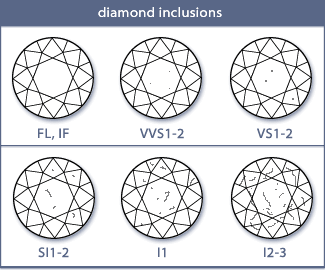|
|
|
Clarity
The
number, location, size, and type of inclusions — trace minerals, fractures, or
other tiny flaws — determines the clarity grade of a diamond. With so many
variables, the gemological laboratories that grade diamonds must apply a
detailed system of rules and standards in order to summarize a clarity grade.
Reading the Clarity Plot
The charts below are clarity
plots, which show the number and size of inclusions typically present in
diamonds of a particular clarity grade. Look for a clarity plot on a diamond
certificate, or grading report, to get a clear idea of the number and size of
inclusions in a particular diamond. From this map, you can gauge a diamond's
clarity without even seeing the diamond.

How to Grade Clarity ?
Gemologists use grades of
clarity to summarize the number, location, size, and type of inclusions a
diamond has. These grades range from flawless (FL) and internally flawless (IF)
to included (I3), with the numbers indicating varying degrees of quality within
a grade (1 being the best). All diamonds at Amir Agha range from flawless (FL)
to slightly included (SI2) and are "eye-clean," which means flaws are
difficult to notice through the crown without magnification.
What Clarity grade is the Best ?
We recommend that you select
a diamond that has no inclusions visible to the unaided eye, like VS1 and VS2.
Diamonds of this clarity are much less expensive than flawless diamonds, and
will not contain inclusions that would otherwise detract from the beauty of the
diamond. But, if you'd rather not compromise on clarity but are budget
conscious, choose a diamond with a good cut and G or H color.
The table below compares the
prices of diamonds with the same color grade (H) and carat weight, but
varying clarity grades.
At a Glance :
FL,
IF Diamonds: Flawless,
internally flawless. No internal flaws.
VVS1, VVS2 Diamonds: Very, very slightly
included. Very difficult to see inclusions under 10x magnification.
VS1, VS2 Diamonds: Very slightly included.
Unable to see inclusions with an unaided eye.
SI1, SI2 Diamonds: Slightly included. Easy to
see inclusions with 10x magnification, but may not see them with unaided eye.
I1, I2, I3 Diamonds: Included. Inclusions
visible to the unaided eye.